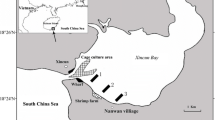Abstract
Dissolved organic matter (DOM) is quantitatively the most significant pool of organic matter in lakes. Within DOM, the pool of dissolved organic carbon (DOC) is dominated (50–80%) by humic substances (HS). The aim of the present study was to determine the changes in quality of DOM along the longitudinal axis of Lake Balaton from the mouth of the Zala River (main inflow) to the eastern part (single outflow) of the lake. The composition of organic fractions and the contribution of HS to the total organic carbon (TOC) pool were determined. Different analytical methods (organic carbon analysis, size fractionation, colour and fluorescence measurements) were used. Our results demonstrated that in the total organic carbon pool of the lake, DOC was the dominant fraction (82–96%). The humic substances made up 75% of DOC at the mouth of the Zala River, and decreased to 55% toward the eastern part of the lake, while the contribution of fulvic acids (FA) to the HS pool increased from 75 to 99%. Along the longitudinal axis of the lake not only did the contribution of humic substances to the total DOC pool decrease, but also the Pt-colour and the fluorescence intensity, while the proportion of the higher molecular weight fractions increased, suggesting that the organic substances became more refractory.
Similar content being viewed by others
References
Aiken, G. R. & R. L. Malcolm, 1987. Molecular weight of aquatic fulvic acids by vapour pressure osmometry. Geochimica et Cosmochimica Acta 51: 2177.
Coble, P. G., 1996. Characterization of marine and terrestrial DOM in seawater using excitation – emission specroscopy. Mar. Chem. 51: 325–346.
Cooper, W. J. & D. R. S. Lean, 1989. Hydrogen peroxide concentration in a northern lake: Photochemical formation and diurnal variability. Environ. Sci. Technol. 23: 1425–1428.
Cronan, C. S., 1990. Patterns of organic acid transport from forested watersheds to aquatic ecosystems. In Perdue, E. M. & E. T. Gjessing (eds), Organic Acids in Aquatic Ecosystems. Wiley: 245–260.
Curtis, P. J., 1998. Climatic and hydrologic control of DOM concentration and quality in lakes. In Hessen, D. O. & L. J. Tranvik (eds), Aquatic Humic Substances. Springer: 93–105.
Cuthbert, I. D. & P. del Giorgio, 1992. Toward a standard method of measuring color in freshwater. Limnol. Oceanogr. 37: 1319– 1326.
Engstrom, D. R., 1987. Influence of vegetation and hydrology on the humus budgets of Labrador lakes. Can. J. Fish. Aquat. Sci. 44: 1306–1314.
Frimmel, F. H., 1998. Characterization of natural organic matter as major constituents in aquatic systems. J. Contamin. Hydrol. 35: 201–216.
Gorham, E., W. E. Dean & J. E. Sanger, 1983. The chemical composition of lakes in the north-central United States. Limnol. Oceanogr. 28: 287–301.
Hautala, K., J. Peuravuori & K. Pihlaja, 2000. Measurement of aquatic humus content by spectroscopic analyses. Wat. Res. 34: 246–258.
Imai, A., T. Fukushima, K. Matsushige & Y. H. Kim, 2001. Fractionation and characterization of dissolved organic matter in a shallow eutrophic lake, its inflowing rivers, and other organic matter sources. Wat. Res. 35: 4019–4028.
Kukkonen, J., J. F. McCarthy & A. Oikari, 1990. Effects of XAD-8 fractions of dissolved organic carbon on the sorption and bioavailability of organic micropollutants. Arch. Environ. Contam. Toxiciol. 19: 551–557.
McKnight, D. M. & G. R. Aiken, 1998. Sources and age of aquatic humus. In Hessen, D. O. & L. J. Tranvik (eds), Aquatic Humic Substances. Springer-Verlag: 9–39.
MacCarthy P. & I. H. Suffet (eds), 1989. Aquatic Humic Substances. Influence on Fate and Treatment of Pollutants. Advances in Chemistry Series 219: 834 pp.
Mounier, S., N. Patel, L. Quilici, J. Y. Benaim & C. Benamou, 1999. Three-dimensional fluorescence of the dissolved organic carbon in the Amazon River. Wat. Res. 33: 1523–1533 (in French).
Newcombe, G., M. Drikas, S. Assemi & R. Beckett, 1997. Influence of characterised natural organic material on activated carbon adsorption: I. Characterisation of concentrated reservoir water. Wat. Res. 31: 965–972.
Peuravuori, J. & K. Pihlaja, 1991. Isolation and fractionation of humic substances in lake waters. In Allard, B., H. Borén & A. Grimvall (eds), Humic Substances in the Aquatic and Terrestrial Environment. Springer-Verlag: 123–134.
Rasmussen, J. B., L. Godbout & M. Schallenberg, 1989. The humic content of lake water and its relationship to watershed and lake morphometry. Limnol. Oceanogr. 34: 1336–1334.
Standard Methods, 1995. In Eaton, A. D., L. S. Clesceri & A. E. Greenberg (eds), 19th Edition American Public Health Association, Washington.
Steinberg, C. & U. Muenster, 1985. Geochemistry and ecological role of humic substances in lakewater. In Aiken, G. R., D. M. McKnight & R. L. Wershaw (eds), Humic Substances in Soil, Sediment, and Water. John Wiley & Sons: 105–145.
Thurman, E. M., 1985. Organic Geochemistry of Natural Waters. Martinus Nijhoff/Dr W. Junk Publishers, Boston: 350 pp.
V.-Balogh, K. & L. Vörös, 1996. Dissolved humic substances in Kis-Balaton reservoirs and their effect to the Keszthely basin of Lake Balaton. 2. Kis-Balaton Ankét. PATE. Keszthely: 555–565 (in Hungarian).
V.-Balogh, K. & L. Vörös, 2001.Wetlands on the watershed of Lake Balaton and their impact on water quality. BIWAKO 2001. 9th International Conference on the Conservation and Management of Lakes. Conference Proceedings. Session 5. 5B-P06: 197–200.
V.-Balogh, K., E. Koncz & L. Vörös, 1999. An empirical model describing the contribution of colour, algae and particles to the light climate of slallow lakes. Verh. int. Ver. theor. angewand. Limnol. 27: 2678–2681.
Wang, Z.-D., B. C. Pant & C. H. Langford, 1990. Spectroscopic and structural characterization of a Laurentian fulvic acid. Notes of the origin of the colour. Analytica Chimica Acta 232: 43–49.
Wetzel, R. G., 1983. Limnology. Saunders: 767 pp.
Williamson, C. E., D. P. Morris, M. L. Pace & O. G. Olson, 1999. Dissolved organic carbon and nutrients as regulators of lake ecosystems: Resurrection of a more integrated paradigm. Limnol. Oceanogr. 44: 795–803.
Author information
Authors and Affiliations
Rights and permissions
About this article
Cite this article
V.-Balogh, K., Vörös, L., Tóth, N. et al. Changes of organic matter quality along the longitudinal axis of a large shallow lake (Lake Balaton). Hydrobiologia 506, 67–74 (2003). https://doi.org/10.1023/B:HYDR.0000008613.82484.0c
Issue Date:
DOI: https://doi.org/10.1023/B:HYDR.0000008613.82484.0c




